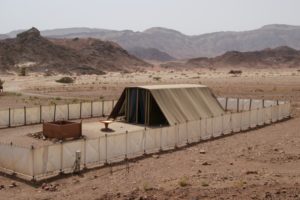[Greek] σκηνή (skēnē), [Latin] tabernaculum, [Latin] habitare: dwelling, tabernacle, tent, scene, building background for a dramatic performance, habitat, shelter, booth, place; Mt.17:4, Heb.11:9, Act.7:44, Heb. 8:2,5

An existing model of the Tabernacle in Jerusalem
Background Information:
Greek Hellenism: Outside the bible, this term can mean dwelling, abode, lodging, and tent. In their travels, soldiers and herdsmen camped in tents. Those who took part in religious feasts and the games also camped in tents. Sometimes shrines were set up among them in portable tents.

The skene is the structure at the back of the stage
Greek stage: The skene was the structure at the back of the theater stage facilities. The skene, behind the stage, was a framework of pillars with movable walls. Painted panels provided the background scenes for the drama. Actors’ costumes were stored in this structure. Serving as a hidden stage, the skene allowed actors to perform and retreat from the stage. The theater of Dionysus is a major amphitheater in Athens. These structures became extremely widespread throughout the Greco-Roman culture.
Old Testament: The earliest sense of this term took on the meaning of a tent. The use of tents was very common during this time. This story begins with the patriarchs in the tents of Abraham. We find the biblical stories of Isaac, Jacob, and Jethro in tents. The wondering nomads and herdsmen lived in tents. In their travels, the army lived in tent encampments. Participants of the Feast of Tabernacles lived in tents. The tabernacle eventually becomes the successor to the tent in hosting religious functions. The tabernacle has often been called the “tent of meeting” or “place of dwelling.” Tabernacles are generally enlarged tents, booths, or huts with roofs made of thatched leaves or other materials. The tabernacle is seen as the place where God may visit or dwell in the community. Moses was given instructions from God on Mt. Sinai on how to build the tabernacle. This earthly tabernacle is built according to the pattern of the heavenly tabernacle. The purpose of the Tabernacle was to house the Ark of the Covenant, containing the manna, the tablets, and Aaron’s staff.
New Testament: According to Luke, the rise of the Christian community (Jewish Christians and Gentile Christians) fulfills the restoration of David’s hut. The distinction is made between the heavenly tabernacle and the earthly tabernacle built by human hands. From Mt. Sinai, Moses received instruction to build the earthly tabernacle. Jesus, becoming the new tabernacle who will dwell among us, refers to Christology. Revelation points forward to future eschatological salvation.
Scripture:
“By faith Abraham sojourned in the promised land as in a foreign country, dwelling in tents with Isaac and Jacob, heirs of the same promise.” Heb 11:9
Wanderers and travelers resided and rested in these movable tents.
“They worship in a copy and shadow of the heavenly sanctuary, as Moses was warned when he was about to erect the tabernacle. For He says, ‘See that you make everything according to the pattern shown you on the mountain.’” Heb.8:5
The tabernacle that was built was built by Moses was only a shadow of the heavenly sanctuary. Jesus is the true tabernacle.
“Then Peter said to Jesus in reply, ‘Lord, it is good that we are here. If you wish, I will make three tents here, one for you, one for Moses, and one for Elijah.’” Mt.17:4
Tents were set up to celebrate religious events. A tent of meeting is a place where one encounters God. This recalls the feast of Tabernacles.
Conclusion:
Scene, scenic, tabernacle, habitation
It can be said that the tent of meeting or tabernacle provides the scene (setting) for encountering God in the Old Testament. As societies moved away from a nomadic culture, it is understandable that tents would be replaced by temples and synagoges. The Eucharist is stored in the tabernacle of Catholic churches. In addition to Mass, this is where Catholics encounter Jesus in the Eucharist.
The Greco-Roman use of skene should not be minimized. This term provides a very important contribution to the stage and performing arts throughout history. Now I will take my cue and exit the stage.–[End Scene]–
